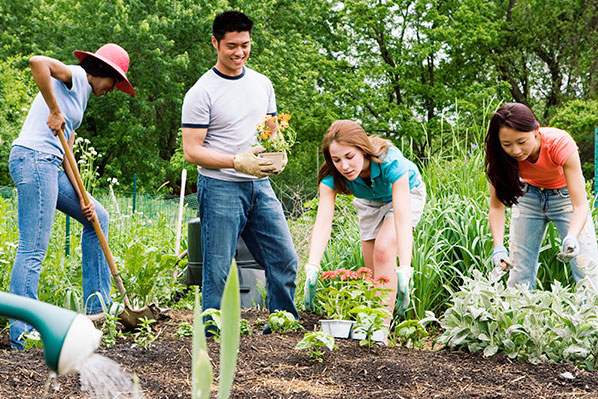By Erin Rempala

America is undergoing a quiet revolution in the way we think of food-production and land use. It’s a revolution called urban farming. From tiny backyard garden plots, to community gardens on former vacant lots, to rooftops on Manhattan high-rises, to the lawn of the White House, Americans are reconsidering the idea of growing healthy, chemical-free, tasty organic food right in their own neighborhoods.
Some people come to this revolution because there is no convenient source of quality, organic food in their urban area (such areas, which are especially common in economically distressed neighborhoods, are called food deserts). Others come to it because they realize that the mass-produced food they find in their local supermarkets simply lacks flavor. Others become interested because of the social implications of locally-produced, healthy food—they ask how should we plan our cities so that healthy food can be available to everyone (a concept known as food justice)—how disadvantaged social groups can be made into cohesive social units through shared community gardens, what role farmer’s markets can play in giving a neighborhood a sense of identity, and what environmental benefits come from local food production and distribution.
Purchasing local food helps the local economy, helps the farmer, and reduces the environmental damage incurred in industrial agriculture and in transporting food long distances—the average distance that that “fresh” tomato you see on the grocery store shelf has traveled from farm to store is 1500 miles! Food that is produced locally is fresher—most likely having been picked within a day or two—and as a result of being allowed to fully ripen before being picked, actually contains more nutrients. Today, one of the most well known sources of local food is farmer’s markets. More than 4000 formal farmer’s markets—and many more thousands of informal neighborhood co-ops and community supported agriculture drop-off locations—now exist in the US. These markets and collectives supply local produce from approximately 50,000 farmers.
I like good food, and at some point in the early 2000s, because I already was interested in conservation and eating healthy, I discovered organic food. Last year, I lived in an integrated neighborhood in Boston, a big East Coast city that is, surprisingly, a food desert. Many of the people in my neighborhood had to take buses to get to the nearest grocery store, miles away. Tired after a long day’s work and family responsibilities, they found themselves eating convenient foods—fast foods and processed foods. San Diego is less of a food desert than Boston, but still in many areas access to good food is limited.
Over the years, as grocery stores have followed people to the suburbs, food stores in many cities, such as a Detroit and New Haven, started closing down in droves. Even cities such as San Diego, which has a wealth of grocery stores and food options, have neighborhoods—such as City Heights and southeast San Diego—where fast food and liquor stores greatly outnumber grocery stores. Improving access for everyone to healthy food is one of many reasons why locally grown, sustainable food is increasingly important. We urgently need more sustainable outlets for organically and locally grown food to serve populations that typically don’t have access to them.
Another mechanism to increase the availability of good food in a community—and to increase community cohesiveness—is to develop community gardens, such as the International Rescue Committee’s (IRC) New Roots Community Farm and Aqua Farm, where members of the community can rent a plot for a nominal fee and grow their own food. Community gardens are particularly useful if you live in an apartment or rent a house where you are unable to grow food in your yard. Novice urban farmers can learn from others at the community garden. Here in San Diego, there are sustainable urban agriculture workshops, and a few universities and colleges are offering courses and training programs to educate young and old alike on how to grow fresh, organic produce at home.
This is why locally grown, sustainable food and urban gardening has gained so much momentum as a social movement. With improved access comes improved nutrition, which translates to better health. The challenge is to bring us back to the land, get our hands in the soil, and reconnect with our creative selves to imagine what is possible within a city setting.
[Update: May 1, 2015]
Urban farming expert Erin Rempala earned a certificate in the Sustainable Business Practices program from UC San Diego Extension, as well as holding a M.A., Biology: Ecology & Systematic Biology from San Francisco State University. UC San Diego Extension also offers courses and programs in nutrition.